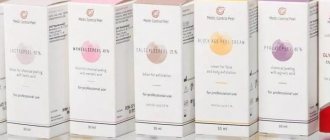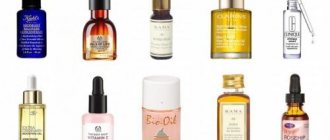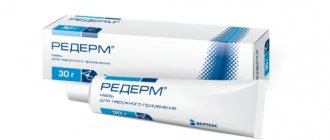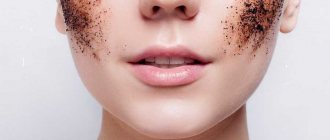{ "@context": "https://schema.org", "@type": "VideoObject", "name": "Peeling roll for face. What it is? How to use? The secret to perfectly clean skin.", "description": "Peeling roll for the face. What it is? How to use? The secret to perfectly clear skin.", "thumbnail": "Peeling roll for the face. What it is? How to use? The secret to perfectly clear skin.", "thumbnailUrl": "https://i.ytimg.com/vi/-N4VYcvIDoQ/maxresdefault.jpg", "uploadDate": "2019-09-15", "duration": "P04M18S ", "embedUrl": "
» }
Did you know that the average life cycle of skin cells is only four weeks? What happens to old cells? Healthy skin usually gets rid of dead particles on its own. But unfavorable environmental conditions, hormonal imbalances and harmful UV rays slow down the natural renewal process. As a result, the skin looks dull and sluggish, pores become clogged, and inflammation appears. Is this a familiar story? Then your skin needs a little help! The Korean facial peeling roller will help to carefully cleanse it of dead skin particles and restore a healthy glow.
What is a peeling roller, how to use it and which one to choose? Let's talk.
— Is it possible to do chemical peeling at home?
— Cosmetologists, as a rule, do not recommend doing home facial peeling using chemicals, because they often encounter complications that patients receive as a result of such amateur activities. Manufacturers of cosmetics, on the contrary, promote their products and convince them that chemical peeling is possible at home.
I think that chemical peeling can be done at home only if several conditions are met:
- home facial peeling should be gentle and superficial (you can only use AHA peels - an alpha-hydroxy acid group of peels in the form of a gel or foam);
- instructions for using peeling must be strictly followed;
- two weeks before peeling, you should not use other abrasive or invasive techniques, medications or cosmetics that affect skin permeability.
Determining the frequency of the procedure based on skin type
- Dry
Girls with this skin type should not overuse chemical facial cleansing. It is enough to perform the procedure every seven to nine days. It is better to give preference to products that contain alpha hydroxy acids. They help the skin more easily absorb nutritional ingredients after cleansing.
- Combined
Women with a combination type, that is, who have certain areas of the face that are dry, such as the cheeks, and others that are oily, such as the T-zone, should cleanse after 4-5 days. During this period, the epidermis has time to fully recover, and the effect of the procedure does not decrease.
- Fat
For girls with an increased level of secretion from the sebaceous glands, it is preferable to carry out chemical peeling after three days. This frequency does not provoke the appearance of inflammation and redness, and ensures proper cleansing. Choose products containing salicylic acid, it regulates the secretion of the sebaceous glands well.
— That is, you do not recommend doing medium and deep types of peeling at home?
- I absolutely do not recommend it. If the product is intended for superficial peeling, it means that it will act exclusively in the upper, stratum corneum layer of the skin; accordingly, even if something goes wrong, the risk of side effects is very small. Superficial home facial peeling does not require a rehabilitation period - everything goes unnoticed, after which only slight peeling of the skin is possible.
Medium peeling acts down to the basal layer of the skin, and deep peeling completely destroys the basal layer and affects the dermis. Medium and deep peels are not always easy to apply, and most importantly, they have a rehabilitation period that can only be carried out under the supervision of a doctor. Some types of deep peeling can only be performed by plastic surgeons and only in specialized medical institutions!
What do you need to know about peeling and pre-peeling preparation?
A preliminary consultation with a specialist will allow you to identify the type and characteristics of your skin, which will be the determining factor when choosing a suitable peeling. The dermatologist should find out if the patient has any possible contraindications for the upcoming cleansing procedure. Such restrictions include: the period of bearing and feeding a child, chronic, cancerous and skin diseases, deep wounds, abrasions, etc., recurrent herpes. It is important not to forget to inform the cosmetologist about the complex use of hormonal agents, antibiotics and other medications. This information plays an important role in the selection and permissibility of peeling.
After collecting all the necessary information obtained during medical research, the doctor prescribes a peeling option suitable for the patient (depth, type). The specialist must inform about the preliminary preparation of the skin for the process of deep cleansing of the stratum corneum (exfoliation), about the procedure itself, about the possible consequences and the result after complete recovery.
— What complications can arise after peeling at home and how to deal with them?
— There can be a lot of complications, but encountering them can be avoided if you pay attention to the indications and contraindications for the use of cosmetics intended specifically for home use.
And, I repeat, strictly follow the instructions. Unfortunately, many patients tend to violate the rules of use - for example, leave the product on longer, instead of the recommended 10 minutes, leave it for the entire 15 - “so that there is definitely an effect.” As a result, the effect will not increase, but, on the contrary, unforeseen problems will arise. If the instructions say “if you feel a burning sensation, remove the product immediately,” then you should not ignore this warning and stoically endure until the last. You should not take such liberties during home peeling.
There is no need to eliminate complications on your own; it is better to consult a doctor immediately. The most common complication after peeling is pigmentation, which you have to put up with for several weeks or months. Pigmentation occurs, among other things, due to non-compliance with the rules of post-peeling care.
Step-by-step technology
- Wash your hands with soap.
- Remove makeup and cleanse your face with your usual product (tonic, foam, gel, etc.).
- Wash your face with water and dry your face with a towel.
- Apply Vaseline to the eye area, lips and eyebrows. This will help protect delicate areas from the effects of the drug.
- Read the recommendations for using the peeling product and strictly follow the application instructions.
- Using a brush or cotton swab, apply the composition first to the nose and chin, then to the forehead and cheeks. Make sure that the mixture is evenly distributed.
- Leave the product on the skin for the time indicated in the instructions. For the initial procedure, a minimum period of time is sufficient; depending on the frequency of use, you can increase the amount of time.
- Monitor your skin's reaction; if you feel any discomfort, remove the product immediately.
- After time has passed, rinse off the product with cool water or a special tonic that neutralizes the effects of acids.
- Treat your face with a product to restore pH balance.
- After the product is completely absorbed, apply a moisturizer.
— How to properly care for your skin after home peeling?
— Post-peeling care is very important. After all, in the process of exfoliation you removed the upper stratum corneum of the skin and stimulated the dermis, as a result the skin becomes more vulnerable and sensitive to the sun's rays. After peeling, you should not do any other aggressive procedures.
It is very important after peeling the skin to take care of its protection from the sun. The use of sunscreen after any peeling, both medical and home, is mandatory!
After peeling at home, it is necessary to take both immediate (immediately after the procedure) and rehabilitation measures (starting from the second day after the procedure). Immediate post-peel care is aimed at reducing the inflammatory reaction, and the rehabilitator should create comfort for the skin (using moisturizing creams, for example, with vitamin E, and sunscreen).
Peeling roll: how to use
How to properly use peeling with rolling particles?
- Korean peeling roll is a means of additional cleansing. Therefore, it is applied to a clean face, like other peels or scrubs. If you apply the roller on dirty skin, there is a high probability that the desired effect will not be achieved, and you will simply “roll” the remnants of the make-up along with other contaminants over the skin.
- It is better to apply the gel to dry facial skin with dry hands. Water reduces friction. Apply the product to your face and make gentle circular movements with your hands along the massage lines until you have rolled off all the peeling. Then simply rinse your face.
- The peeling roll is considered a gentle cleanser, but it is still not recommended to use it every day. For oily skin, the exfoliation procedure can be performed 1-2 times a week. For dry and sensitive - 1 time every 1-1.5 weeks.
- As after using a regular peel, it is recommended to use sunscreen cosmetics after rolling.
Combination with cosmetic procedures
Chemical peels are harmoniously integrated into various cosmetology techniques to enhance the effect.
- The introduction of botulinum toxin and fillers for additional correction of age-related changes occurs 2-3 weeks after superficial-medial peelings.
- Mesotherapy - the introduction of specialized cocktails into the middle layer of the skin to stimulate cellular processes of self-regulation and renewal is carried out before or after procedures in 3-10 days.
- Biorevitalization - the use of preparations containing hyaluronic acid to maintain the required level of hydration and increase regeneration is carried out 5-10 days after superficial and medium peels.
conclusions
Gel peels are intended primarily to cleanse the face of dead skin cells and sebum. But due to the fact that the composition contains various ingredients, they also perform another important role:
- Even out the microrelief of the skin.
- Nourishes and softens the skin.
- Eliminate post-acne and minor inflammations. And also blackheads.
- Pigment spots become less noticeable.
But before buying a cosmetic product of this type, you should determine your skin type. In addition, there are some contraindications to their use. Therefore, the choice of gel should be taken responsibly; before purchasing, read the instructions on the package.
Expected effects
Depending on the type, quantity, and depth of peelings, certain mechanisms occur.
- Exfoliation, cleansing and whitening of the skin (removal of dead cells, age spots).
- Activation of biological functions and cellular resources (antioxidant effect).
- Moisturizing (synthesis of hyaluronic acid).
- Normalization of the sebaceous glands and narrowing of pores.
- General skin rejuvenation (increasing elasticity, smoothing the relief, reducing wrinkles, smoothing out creases).
- Renewal of cellular structures (correction of scars and stretch marks).
- Increases blood circulation and strengthens blood vessels.
- Restoration of skin immunity and barrier functions.
- Achieving skin tightening (lifting effect).
- Normalization of the density and elasticity of the epidermis.
- Formation of new contours and improvement of the structure of the face and body.
Preparing the skin for physical peeling
Physical peeling is a procedure for cleansing and rejuvenating the skin using innovative technical devices. This type of peeling includes exposure to ultrasound and laser, hardware facial cleansing using special exfoliating creams and rotating brushes (brossage), simultaneous temperature and mechanical effects on the skin of the face (gas-liquid peeling), application of carbon-based gel masks (carbon peeling) etc. Most types of physical peeling gently and carefully cleanse any type of skin, with the exception of only a few procedures: laser exposure of the skin and diamond micro-grinding of the skin.
Preparation for physical peeling requires compliance with the following conditions:
- 7 days before the upcoming procedure, limit trips to saunas, swimming pools, baths;
- 14 days before the cleaning process, you should avoid going to the solarium or exposing your skin to direct sunlight;
- every day for 7 days before the procedure, you must use a sunscreen with a protection level of 35 SPF;
- inflammatory processes on the skin (acne, pimples) must be eliminated;
- you should use antibacterial drugs if you have herpes (viral disease) on your skin;
- 7 days before the procedure, you cannot use any facial scrubs that contain large solid particles (abrasives): apricot kernels, coffee, almonds, nut shells, sea salt, etc. It is prohibited to use cleansing creams with a more gentle and gentle effect (gommage) and other cosmetic preparations based on acids;
- If the upcoming peeling is to get rid of pigmentation on the face, then 7 days before the procedure you need to start using products with a whitening effect. They will stop the appearance of new cells that produce the pigment melanin (melanocytes). Such drugs include creams with a lightening effect and lotions containing acids.










